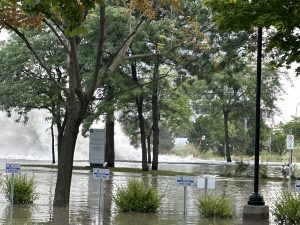A panel discussion on the challenges and opportunities faced by the construction workforce in the design, construction and commissioning of high-performance buildings was featured at the recent Buildex Vancouver 2020.
Entitled Trading Up: Addressing the Skills Gap in Construction, the session was based on the premise that the transition to a low-carbon economy is one of today’s most pressing issues and that it will require the B.C. construction workforce to adapt, retrain and up-skill.
Still relatively new, high-performance building is poorly understood by many people in industry and government.
Both skills and attitudes will need to change if the required adjustments in the workforce are to take place.
To discuss these and related matters were panelists Akua Schatz, vice-president, advocacy and market engagement, Canada Green Building Council; Fiona Famulak, president, Vancouver Regional Construction Association; Phil Davis, managing director, Electrical Joint Training Committee; Mary McWilliam, School of Construction and Environment, BC Institute of Technology; and Kristi Seddon, business development, Ledcor Construction Limited.
The panel discussed three questions:
Knowing we need to get to zero emissions by 2050, where do you see the gaps in the construction industries?
What are you/your organization doing to address these gaps?
What is outside your control that needs to happen?
“Historic design and construction practices will not allow industry to achieve the performance thresholds specified in the BC Energy Step Code,” said McWilliam.
Schatz says the discuss focused on BC because “the province is ahead of the rest of the country in performance regulations.”
A related but different Buildex Vancouver workshop looked at a building performance standard that is comparatively new to BC.
Joel Good, principal and senior sustainability consultant at RWDI Consulting Engineers and Scientists, led a half-day workshop on WELL building standards.
Launched in October 2014, WELL joins a group of other environmentally enlightened building standards, such as LEED, Passive House and the BC Energy Step Code.
WELL is a performance-based system that measures, certifies and monitors seven features of the built environment that impact human health and well-being: Air, water, nourishment, light, fitness, comfort and mind.
“The focus of WELL is occupant well-being,” said Good. “That’s unlike other building standards that focus on a building, rather than its occupants. We want to create healthful places for people to live and work in.”
At the same time, WELL has been designed to work with LEED and other green building systems.
“The workshop was a four-hour introduction to WELL standards and the WELL certification process,” said Good. “It was aimed at building owners, contractors and designers and anyone else who is interested in healthful buildings and who wants to learn about WELL.”
WELL notwithstanding, an increasing number of projects are being built to satisfy more than one performance standard.
A case in point is the University of Victoria Student Housing and Dining project, which comprises an eight- and an eleven-story building, one of which contains a commercial kitchen.
The project is being designed and constructed to meet BC Energy Step Code level 4, Passive House (PH) and LEED v4 certification.
Along with Ruffy Ruan, project manager at Integral Group, Kaz Bremner, senior architect at Perkins & Will, the designer, discussed the 782-bed project.
It is being touted as a bar-raiser for student housing at Canadian and international post-secondary institutions.
“We’ve been seeing increasingly ambitious building performance standards and environmental goals for student residences in Canada, such as the Skeena residence at the UBC Okanagan campus,” said Bremner. “But the UVic project is unique because of its scale and complexity and the different uses that need to be accommodated.”
The project has had to jump through numerous PH hoops, such as stringent seismic design requirements, high ventilation rates and high plug loads (energy used by equipment that is plugged into an outlet) associated with student housing.
After considering the energy impact of conventional gas-fired appliances, UVic wants to make the kitchen as electric as possible, relying mostly on induction cook tops.
“High performance standards for student housing are more common in other parts of the world where energy is scarce and expensive,” said Bremner.
Site servicing started recently. Foundations will be laid in summer 2020 and completion is expected in 2023.











Recent Comments
comments for this post are closed